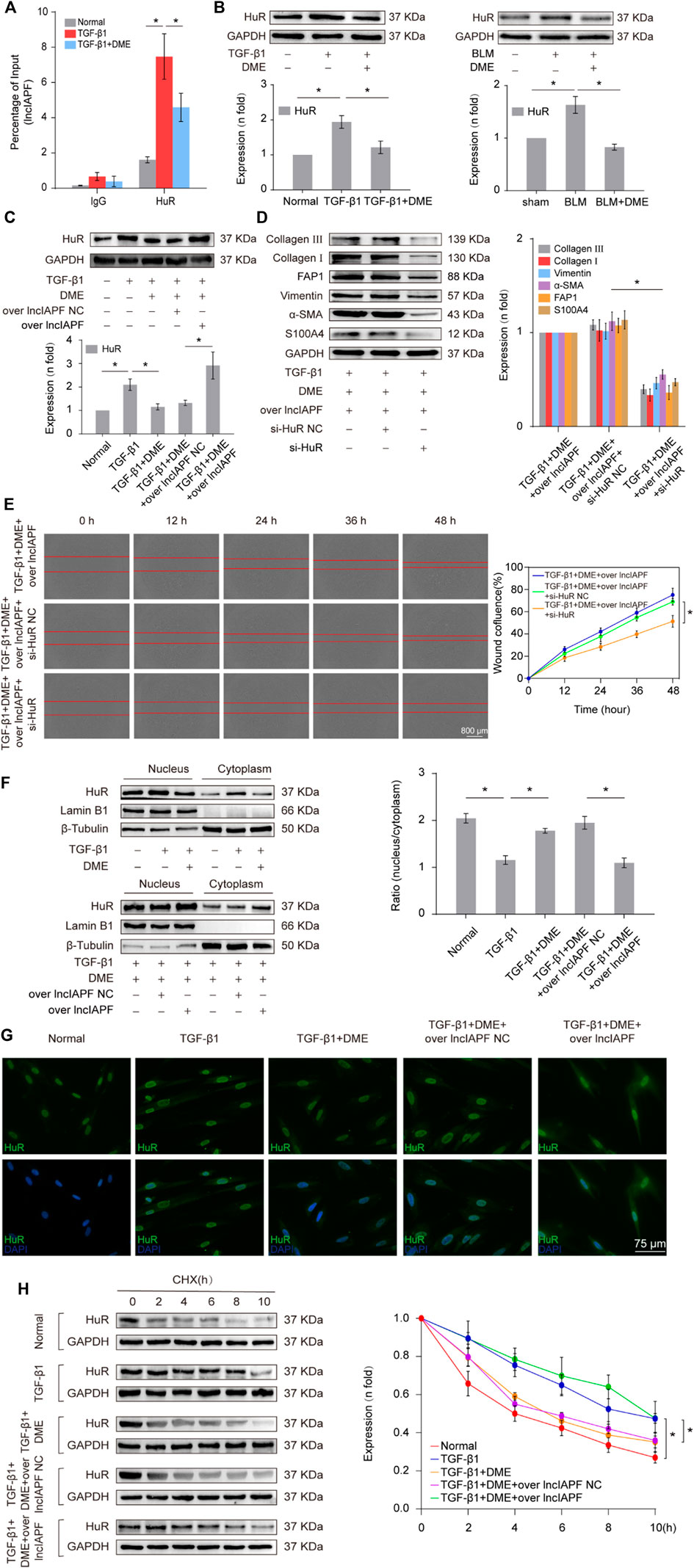Danshensu methyl ester enhances autophagy to attenuate pulmonary fibrosis by targeting lncIAPF–HuR complex
- 1Department of Cellular and Genetic Medicine, School of Pharmaceutical Sciences, Binzhou Medical University, Yantai, China
- 2Department of Respiratory and Critical Care Medicine, Binzhou Medical University Hospital, Binzhou Medical University, Binzhou, China
- 3Medical Research Center, Binzhou Medical University, Yantai, China
- 4School of Gerontology, Binzhou Medical University, Yantai, China
A Corrigendum on
Danshensu methyl ester enhances autophagy to attenuate pulmonary fibrosis by targeting lncIAPF–HuR complex
by Zhu Q, Wang J, Ji Y, Luan J, Yue D, Liu W, Li H, Zhang J, Qu G, Lv C and Song X (2022). Front. Pharmacol. 13:1013098. doi: 10.3389/fphar.2022.1013098
In the published article, there was an error in Figure 5 as published. The quantitative grouping label of the protein bands in Figure 5D was incorrectly labeled as “TGF-β1+DME, TGF-β1+DME + si-HuR NC, TGF-β1+DME + si-HuR”. The corrected Figure 5 and its caption appear below.

FIGURE 5. (Continued). Regulatory mechanism of DME on lncIAPF–HuR. (A) The RIP experiment verified the binding relationship between lncIAPF and HuR and the effect of DME on their binding. (B) Western blot result showed that the expression of HuR increased in the model group and decreased in the treatment group. (C) The rescue experiment of Western blot showed that DME reduced HuR expression, and lncIAPF overexpression increased HuR expression and reversed the downward trend caused by DME. (D) The rescue experiment of Western blot showed that interference with HuR decreased the expression of S100A4, FAP1, α-SMA, vimentin, collagen I and III, and reversed the upward trend caused by lncIAPF overexpression. (E) The rescue experiment of scratch assay showed that HuR interinterference reversed the trend of accelerated migration caused by lncIAPF overexpression. (F) Nucleocytoplasmic separation experiment showed that DME blocked the nucleocytoplasmic translocation of HuR, but lncIAPF overexpression reversed the effect of DME. β-Tubulin was used as the cytoplasmic reference, and Lamin B1 was used as the nucleus. The results of nucleoplasmic separation were quantitatively analyzed by Image J software as follows: Normal: nucleus/plasm = 2.0, TGF-β1: nucleus/plasm = 1.3, TGF-β1+DME: nucleus/plasm = 1.8, TGF-β1+DME + overlncIAPF NC: nucleus/plasm = 1.9, TGF-β1+DME + overlncIAPF: nucleus/plasm = 1.1. (G) Immunofluorescence experiment showed that HuR was primarily localized in the nucleus of normal cells, and it transferred from the nucleus to the cytoplasm under the action of TGF-β1 or lncIAPF overexpression. DME blocked the nucleocytoplasmic translocation of HuR, but lncIAPF overexpression reversed the effect of DME. (H) Cycloheximide experiment verified the stability of the HuR protein. DME weakened HuR stability, but lncIAPF overexpression reversed this trend. The half-life of HuR in each group was presented as follows: normal: T1/2 = 3.07 h, TGF-β1: T1/2 = 10.17 h, DME: T1/2 = 3.92 h, DME + over lncIAPF NC: T1/2 = 4.76 h, DME + lncIAPF: T1/2 = 12.33 h. The concentration of DME used was 10 μg/ml. Each bar represents the mean ± SD; n = 6; *p < 0.05.
The authors apologize for this error and state that this does not change the scientific conclusions of the article in any way. The original article has been updated.
Publisher’s note
All claims expressed in this article are solely those of the authors and do not necessarily represent those of their affiliated organizations, or those of the publisher, the editors and the reviewers. Any product that may be evaluated in this article, or claim that may be made by its manufacturer, is not guaranteed or endorsed by the publisher.
Keywords: pulmonary fibrosis, danshensu, lncRNA, autophagy, HuR (ELAVL1)
Citation: Zhu Q, Wang J, Ji Y, Luan J, Yue D, Liu W, Li H, Zhang J, Qu G, Lv C and Song X (2022) Corrigendum: Danshensu methyl ester enhances autophagy to attenuate pulmonary fibrosis by targeting lncIAPF–HuR complex. Front. Pharmacol. 13:1086927. doi: 10.3389/fphar.2022.1086927
Received: 01 November 2022; Accepted: 21 November 2022;
Published: 02 December 2022.
Edited and reviewed by:
Yang Zhou, Brown University, United StatesCopyright © 2022 Zhu, Wang, Ji, Luan, Yue, Liu, Li, Zhang, Qu, Lv and Song. This is an open-access article distributed under the terms of the Creative Commons Attribution License (CC BY). The use, distribution or reproduction in other forums is permitted, provided the original author(s) and the copyright owner(s) are credited and that the original publication in this journal is cited, in accordance with accepted academic practice. No use, distribution or reproduction is permitted which does not comply with these terms.
*Correspondence: Xiaodong Song, c29uZ3hkNzFAMTYzLmNvbQ==; Changjun Lv, bHVja3lfbGNqQHNpbmEuY29t; Guiwu Qu, cXVndWl3dUBhbGl5dW4uY29t
†These authors have contributed equally to this work
 Qi Zhu
Qi Zhu Jing Wang
Jing Wang Yunxia Ji
Yunxia Ji Jianlin Luan
Jianlin Luan Dayong Yue
Dayong Yue Weili Liu
Weili Liu Hongbo Li2
Hongbo Li2 Jinjin Zhang
Jinjin Zhang Changjun Lv
Changjun Lv Xiaodong Song
Xiaodong Song